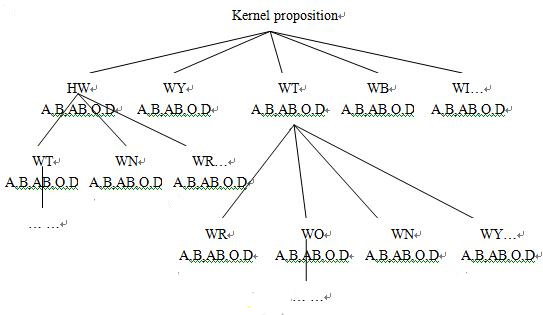DIT (Discourse Information Theory), brought up by Professor Du Jinbang in 2007, has been developed from various aspects including theoretical development, corpus construction, related research methodologies and research tools in recent years.
DIT mainly lays its foundation on Du’s Tree Structure of Discourse Information (TSDI). Based on Büring’s tree structure model (Büring, 2003), Lasswell’s (Lasswell, 1948) 5W model and Labov’s model of knowledge categories (Labov, 1977), Du (2007) proposes the Tree Information Structure of Legal Discourse which is suitable for both written and oral discourse analysis.
In this model, information is defined as proposition, a relatively independent and complete structure, which has a relatively complete meaning and constitutes the minimal communication unit. This definition reveals the nature of information and its function in communication. Information, in this sense, stands between language and cognition as a bridge and acts as a kind of representation of our knowledge. As a minimal communication unit, information is utilized, processed and shared by different participants, and is developed in the discourse both linearly and hierarchically (Du, 2008).

(note: WT= what, WB= what basis, WF= what fact, WI= what inference, WP= what disposal, WO= who, WN= when, WR=where, HW= how, WY= why, WE=what effect, WC= what condition, WA= what attitude, WG= what change, WJ= what judgment)
As can be seen from the above figure, the kernel proposition is posited in the middle and developed by detailed information units below, which may further be developed by information units, the minimal meaningful unit for communication, at the next lower level. The lines which link the kernel proposition with information units (15Ws: WT, WB, WF, WI, WP, WO,WN, WR, HW, WY, WE, WC, WA, WG, WJ), and the superordinate information units with lower-level subordinate information units represent their relationships, which are termed as information knots. Each information knot can be vested with a value, P (beneficial to the information knot at upper level ), O (neutral or unknown) or N (not beneficial to the information knot at upper level ). And each one can be tagged with one of A, B, AB, O or D as the information sharing category, which has been recently improved as in the following table, showing the level of sharing certain information in the interaction. The sharing level goes up from A to O (or corresponding marks). A and B categories stand at the lowest level of sharing with AB category in the middle of the scale. O category enjoys both the highest sharing level and acceptance while D category comparatively high sharing level but low acceptance.
| Discourse type |
Sharing category |
note |
| Monologue |
A, B, C, E, O, D |
A: only A knows; B: only B knows; C=AB, A and B both know; E=BA, A and B both unknow; O: all know; D: disputable. |
| Q & A |
a, b, c, e, o, d |
Corresponding with monologue categories |
| Dialogue(other than Q&A) |
R, S, T, Y, Z, U |
Corresponding with monologue categories |
In summary, a discourse has one and only one kernel proposition, and information units at each level can have some subordinate information units. Each unit can be further analyzed from the perspectives of information levels, information knots and the value, information sharing levels, ect. The whole net of hierarchy provides us with a clear picture of the discourse as well.
The above linear and hierarchical structure can be categorized as the macro information structure, while the micro information structure deals with the internal structure of each information unit, elaborating the relationship between the information elements and their forms of presentation. From the micro level, each information unit can be analyzed from three elements: process, entity and environment, and further specified into various types for different functions in the proposition as in the following table. A proposition can be regarded as a process, with the predicate as the core. What is involved in the process is the entity and the process goes under certain conditions.
| P(rocess) |
E(ntity) |
C(ondition) |
| S(tate) |
1(agent) |
i(nstrument) |
| Q(uality) |
2 (dative) |
l(ocation) |
| R(elation) |
3(patient) |
s(ource) |
| A(ffect) |
4 (factitive) |
g(oal) |
| C(ause) |
5 (attribute) |
c(ommititive) |
| T(urn) |
|
t(ime) |
| B(ehave) |
|
a(ffected) |
| |
|
w(ith) |
| |
|
o(situation) |
Both the macro and micro levels construct DIT in a steric, numeric and traceable way.
